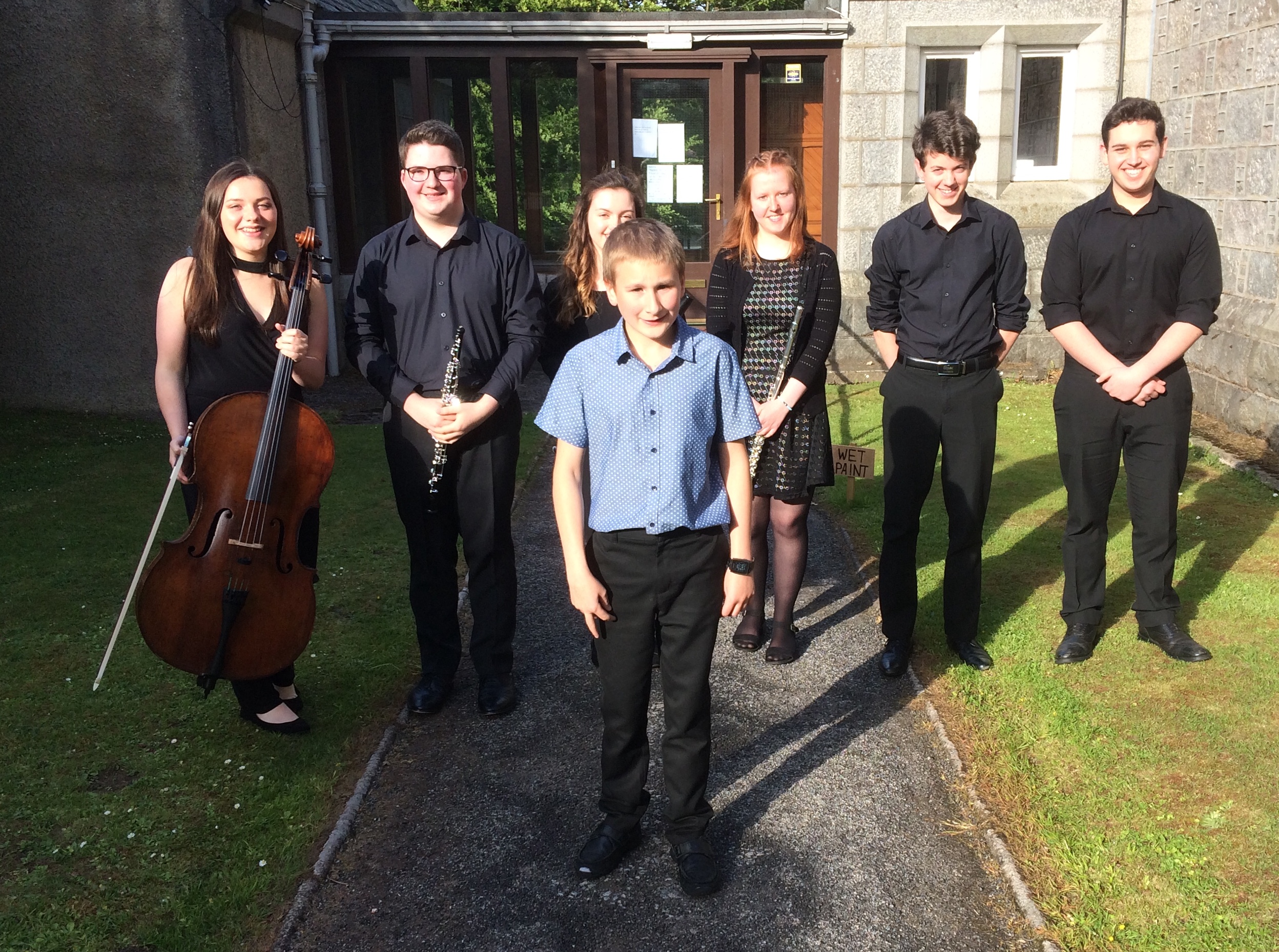click here


As we were informed on the back of today's concert programme, 37 students of the North East of Scotland Music School are currently benefiting from full or partial scholarships. On Friday evening we had the pleasure of hearing seven of the very best of those — and indeed they were exactly that — the very best.
The performance opened with the first of three gifted young pianists. Aaron Magill gave us three strongly contrasting pieces. He began with Chopin's Nocturne in c sharp minor 1830 (published in 1870). This was a splendidly well thought out performance, relaxed and well paced. He continued with an arrangement of Gershwin's popular song 'Let's Call The Whole Thing Off', by Pam Wedgwood. I loved the way that Aaron stressed exactly the right notes in his performance adding just the right rubato too — just as he had done in the Chopin.
Aaron finished with a wonderfully named piece for piano by Brian Bonsor better known for his recorder music, Willie Wagglestick's Walkabout. Aaron captured the jazzy spirit of this music to perfection. Most of all I thought that Aaron's performance was remarkably mature. He did not just play the notes, he played the music. There is a great difference and it really matters. I felt that Aaron had internalised the very different spirit of each of his three pieces. He understood them and was able to project them on to us, his audience.
Aaron is a pupil at Albyn School where his mother Shirley Magill is a class music teacher. Oboist Christopher Smith is also a pupil at the School and so she was Christopher's gifted accompanist in two fine pieces. The first was the five movement Sonata No.4 in D op 5 (1717) by Jean Baptiste Loellet of Ghent.
Christopher's tone in the slow movements was clean, clear fluent and well breathed. In the faster movements there was a splendid crispness to his playing, often jaunty and well shaped as was demanded by music that is based on the dance. The final movement in particular had all the rhythmic tripping of the dance.
This idea of dance was also very much alive in the opening movement of Sarabande et Allegro by Grovelez. There was just a hint of a swing in the Sarabande. You could almost sense the footfalls of the dance in Christopher's very fine performance. The Allegro was fast and fiery with a splendidly fluent melodic passage in the middle.
Flautist Iona Baillie had chosen a most unusual piece for her performance. Orange Dawn is by Ian Clarke, a distinguished contemporary British flautist and a professor at Guildhall. It paints a musical sunrise in the Great Rift Valley in Africa. This was a wonderful atmospheric piece full of instrumental colour derived from many special flute effects. The piano accompaniment was played with considerable virtuosity by Andrew Leadbetter. He had an extended solo passage in the middle of the piece.
In his introduction, Dr Colin Sinclair said that we were about to hear a duet played on a single flute. How was that going to be possible? Well we soon found out and it was amazing. Iona played a slow steady melody strongly. It really shone from the instrument while more softly, in the background, there was a kind of twiddly- diddly accompaniment that ran through the melody. Now that is what I call a truly virtuoso performance. It left me breathless.
Our second young pianist was Malik Salloum. He began with Mozart's Adagio in b minor. In this performance I was reminded that Mozart was a great composer of stage operas because the contrasts between light and dark, gentle and almost violent that Malik was able to create suggested the heart and soul of drama.
There was a similar contrast of mood in Chopin's Mazurka in c sharp minor Op. 50 No.3. Passages of sadness were set against almost joyful dance with a growing sense of complexity in the music that Malik mastered so well.
Malik's final piece was Rachmaninov's Prelude in g sharp minor Op. 32 No. 12. His performance was rich and full of pianistic colour — almost orchestral. I was reminded of another Rachmaninov piece, The Isle of the Dead. It too has echoes of the Dies Irae within it.
After the Interval came the third pianist Matthew Crabb. I do not wish to underrate the two excellent pianists we had already heard but Matthew went way beyond them. To begin with, the second of his offerings, the Barcarolle and Caprice Italien from the Napoli Suite by Poulenc, was played entirely from memory — and it is very complex music.
For his first piece, Chopin's Impromptu in A flat, Matthew had the score on the piano but I don't think he really looked at it. In my 'crit' of this piece, can I quote Colin Sinclair's excellent programme note? "A delicate tracery loops over the keyboard like a perpetuum mobile leading to a songful middle section" That is precisely what Matthew gave us and I can't describe it any better than that.
His performance of Poulenc's Caprice Italien was particularly exciting. It had dazzling pianistic fireworks and delicious melody. The best way of putting this is simply to say that Matthew gave us a wholly professional performance. Bravo!
Cellist Kara Taylor accompanied firmly and clearly by Colin Sinclair gave us a fine strong performance of the first movement of Beethoven's Cello Sonata No. 3. Lithe muscular fingerboard work and expansive and often very expressive bowing along with explosive pizzicatos gave us all the wonderful variety of Beethoven's imaginative writing. Kara's singing tone in the themes and fine scalar passages added to the enjoyment of this sonata movement.
Kara followed this with Jewish Melody, the final movement of Ernest Bloch's triptych, From Jewish Life. Kara played with real spirit, vehemence even. This was contrasted with passages of lovely gentleness. What can I say except vunderlekh! I should say too that Kara gave warm and enthusiastic compliments to her teacher James Halsey who has taken her to where she is today.
Our final performer on Friday was a marvellous clarinettist, Laura Smith who was also accompanied by Colin Sinclair. She opened her performance with Adagio by Heinrich Baermann (1784-1847). This was a beautifully clean and clear toned performance concentrated on the upper tones of the clarinet. Her second piece, the final performance in the concert, was the third movement from the Sonatina for clarinet and piano by Joseph Horovitz. A light hearted rondo with what Horovitz himself called a 'sense of humour', it was jolly, jazzy and playful put across so brilliantly by Laura and I have to say also by Colin Sinclair.
It made an ideally bright and happy ending to one of the best Scholarship Concerts ever and sent the audience on its way rejoicing.